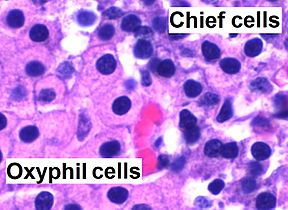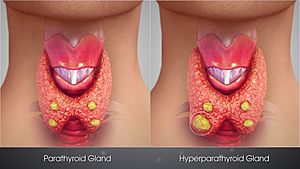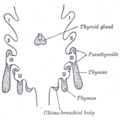Parathyroid gland facts for kids
Quick facts for kids Parathyroid glands |
|
|---|---|
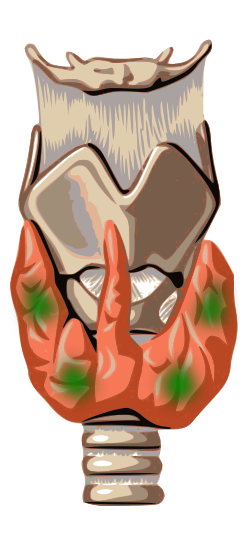 |
|
| Diagram showing structures in the human neck. The four green shaded areas represent the most common position of the parathyroid glands, which are generally four in number and situated behind the lateral lobes of the thyroid gland (shaded orange). | |
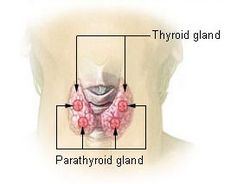 |
|
| Thyroid and parathyroids as viewed from the front of the neck | |
| Latin | glandula parathyreoidea inferior, glandula parathyreoidea superior |
| System | Endocrine |
| Artery | superior thyroid artery, inferior thyroid artery, |
| Vein | superior thyroid vein, middle thyroid vein, inferior thyroid vein, |
| Nerve | middle cervical ganglion, inferior cervical ganglion |
| Lymph | pretracheal, prelaryngeal, jugulodigastric lymph nodes |
| Precursor | neural crest mesenchyme and third and fourth pharyngeal pouch endoderm |
Parathyroid glands are tiny endocrine glands found in the neck of humans and many other animals. Humans usually have four of these glands. They are located on the back of the thyroid gland, which is another important gland in your neck.
The parathyroid glands make and release something called parathyroid hormone. This hormone is super important because it helps control the amount of calcium in your blood and bones. When your blood calcium levels get too low, the parathyroid glands spring into action!
These glands share similar blood vessels and drainage systems with the thyroid gland. They develop from special parts of an embryo called pharyngeal pouches.
Sometimes, the parathyroid glands don't work quite right. If they make too much hormone, it's called hyperparathyroidism. If they don't make enough, it's called hypoparathyroidism. Both of these conditions can affect your blood calcium and bone health.
Contents
What are Parathyroid Glands?
The parathyroid glands are usually found in two pairs, one pair behind each side of your thyroid. Each gland is small, flat, and yellowish-brown, looking a bit like a lentil seed. They are typically about 6 millimeters long.
Most people have four parathyroid glands. The two higher ones are called the superior parathyroid glands, and the two lower ones are the inferior parathyroid glands. Healthy parathyroid glands are very light, weighing only about 30-35 milligrams. They are so small that doctors usually can't feel them during a neck exam.
How Many Parathyroid Glands Can You Have?
While most people have four parathyroid glands, the number can sometimes vary. Some people might have three, or even six or more! Rarely, a parathyroid gland might be found inside the thyroid gland itself, or even in the chest near the thymus.
What Do Parathyroid Glands Look Like Up Close?
Even though their name sounds like "thyroid," parathyroid glands have a totally different job. If you look at them under a microscope, you can see they have tightly packed cells. The thyroid gland has a different, more open structure.
There are two main types of cells in the parathyroid gland:
- Chief cells: These are the cells that make and release parathyroid hormone. They look dark when they are full of hormone and clearer after they've released it.
- Oxyphil cells: These cells look lighter. Scientists aren't quite sure what their job is, but they become more common as people get older.
-
This picture shows a parathyroid gland under a microscope. The white circles are fat cells. About 25-40% of a normal parathyroid gland is made of fat.
How Do Parathyroid Glands Develop?
During the early development of a human embryo, special structures called pharyngeal pouches form. These pouches help create parts of the face and neck. The parathyroid glands grow from the third and fourth of these pouches.
Interestingly, the glands change their position as the embryo grows. The glands that end up being the lower (inferior) ones actually start higher up, from the third pouch, along with the thymus. The glands that become the higher (superior) ones develop from the fourth pouch. As the thymus moves down into the chest, it pulls the inferior parathyroid glands with it. This is why the glands are named after their final spot, not where they started! Sometimes, a gland might not detach properly and can end up in the chest.
What Do Parathyroid Glands Do?
The main job of your parathyroid glands is to keep the levels of calcium and phosphate in your body just right. This is super important for your nervous system and muscular system to work correctly. They do this by releasing parathyroid hormone (PTH).
Parathyroid hormone works against another hormone called calcitonin to balance calcium and phosphate.
- Calcium: PTH helps increase calcium levels in your blood. It does this by telling your bones to release calcium. It also helps your body absorb more calcium from the food you eat and helps your kidneys keep calcium instead of letting it leave your body.
- Phosphate: PTH also controls phosphate levels. It tells your kidneys to get rid of extra phosphate. However, it also helps your body absorb more phosphate from food.
Problems with Parathyroid Glands
Problems with parathyroid glands are usually divided into two main types: when they are too active (making too much hormone) or not active enough (making too little hormone). Both situations can cause symptoms related to calcium levels in your blood.
Too Much Hormone: Hyperparathyroidism
When there's too much parathyroid hormone in your blood, it's called hyperparathyroidism. This can make your bones hurt because too much calcium is being taken from them. You might also feel dehydrated because of high calcium levels.
Primary Hyperparathyroidism
This type usually happens when one of the parathyroid glands grows too much and starts making too much hormone on its own. Doctors often treat this by surgically removing the overactive gland.
Secondary Hyperparathyroidism
This can happen if your kidneys aren't working well. If your body loses too much calcium, the parathyroid glands try to make up for it by producing more hormone. They might even grow bigger to do this.
Tertiary Hyperparathyroidism
If secondary hyperparathyroidism goes on for a very long time, the parathyroid glands might stop responding to your body's calcium levels. They then start releasing hormone all the time, even when they shouldn't.
Too Little Hormone: Hypoparathyroidism
When the parathyroid glands don't make enough hormone, it's called hypoparathyroidism. This often happens if the glands or their blood supply are accidentally damaged during thyroid surgery. It can also be linked to rare genetic conditions.
Sometimes, a person's body doesn't respond to the parathyroid hormone, even if the glands are making enough. This is called pseudohypoparathyroidism. In this case, the hormone is there, but it can't do its job, leading to low blood calcium. This condition is often connected to a genetic condition called Albright's hereditary osteodystrophy.
Symptoms of hypoparathyroidism are usually related to low calcium. Doctors often treat it with special forms of Vitamin D.
A Look Back: History of Discovery
The parathyroid glands were first noticed in an Indian rhinoceros by a scientist named Richard Owen in 1852. He described them as a "small compact yellow glandular body attached to the thyroid."
However, the glands were first discovered in humans by a Swedish medical student named Ivar Viktor Sandström in 1880. He didn't know about Owen's discovery and named them "glandulae parathyroidae." He also found them in many other animals like dogs, cats, and horses. For a while, not many people paid attention to Sandström's discovery.
Later, in 1891, scientists like Eugène Gley and Giulio Vassale started to understand what the glands did. They noticed that if the glands were removed, animals would get muscle spasms. In 1908, William George MacCallum suggested that the glands were important for controlling calcium.
The first successful surgery to remove a parathyroid gland was likely in 1928. Before this, patients whose parathyroid glands were removed often died from severe muscle spasms.
The parathyroid hormone itself was isolated in the 1920s by Adolph M. Hanson and James Collip. Later, studies on hormone levels by Roger Guillemin, Andrew Schally, and Rosalyn Sussman Yalow led to new ways of measuring substances in the body, earning them a Nobel Prize in 1977.
Parathyroid Glands in Other Animals
You can find parathyroid glands in all adult tetrapods, which are animals with four limbs, like mammals, birds, reptiles, and amphibians. The number and position of these glands can be different in various animals. Mammals usually have four, while other tetrapods often have six. If you remove these glands from animals, they get sick with muscle problems, similar to what happens in humans.
Interestingly, fish don't have parathyroid glands. However, some fish species have a hormone that is very similar to parathyroid hormone. Scientists think that the parathyroid glands in tetrapods might have developed over time from parts of fish gills!
Images for kids
See also
 In Spanish: Glándula paratiroides para niños
In Spanish: Glándula paratiroides para niños



